On the Disputed India-Pakistan Border, Skiers Long for Peace
This article originally appeared on Ski Mag
Under the bright sky in early March, Muskan Nabi lines up for the lift on the beginner slope at Gulmarg Ski Area. Face layered with white sunscreen, the 20-year-old is preparing for a junior ski competition at the ski area next week.
"I took my first run on the same slope when I was 6," she says, gazing over the vast snow-covered valley where people appear like ants moving around the distant slopes. "Now, I can't live without Gulmarg."
Nabi lives an hour north of the ski area in Sopore. A student at a local college studies humanities, but in the winter months, she spends most of her free time skiing. Nabi wants to become Gulmarg’s first female ski instructor.
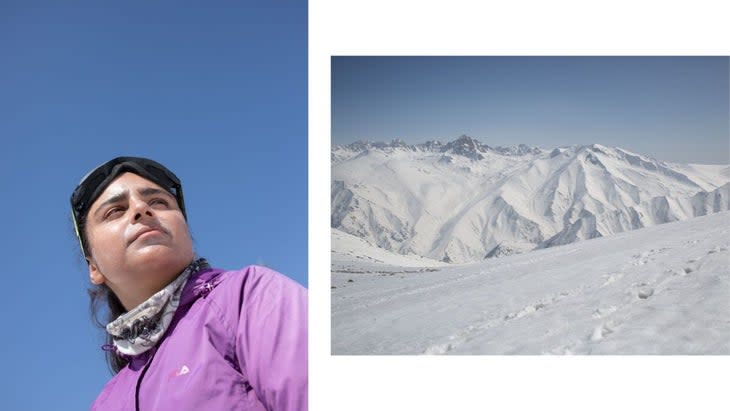
On the slope, two dozen other skiers surround Nabi: girls from a local university taking their introductory course and tourists--men, women, and children--descending the low-angle hill. Their instructors call out reminders--don’t lean backward; look forward.
At the top of the run, hands firmly on ski poles, Nabi looks westwards at Apharwat Peak--the imposing 14,400-foot mountain in the distance. "This is a skier's heaven," she shouts with a bright smile and pushes off.
Ringed by the mountains of Pir Panjal, the northwestern Himalayas, Gulmarg is a vast meadow that starts receiving snow, as much as eight feet, by early December. Located in the Indian-administered Kashmir, the mountains and the valley remain under the white blanket for five months. Already a busy tourist destination in the summer, snow brings in thousands more enthusiastic visitors from the hot plains of India to witness the otherworldly winter.
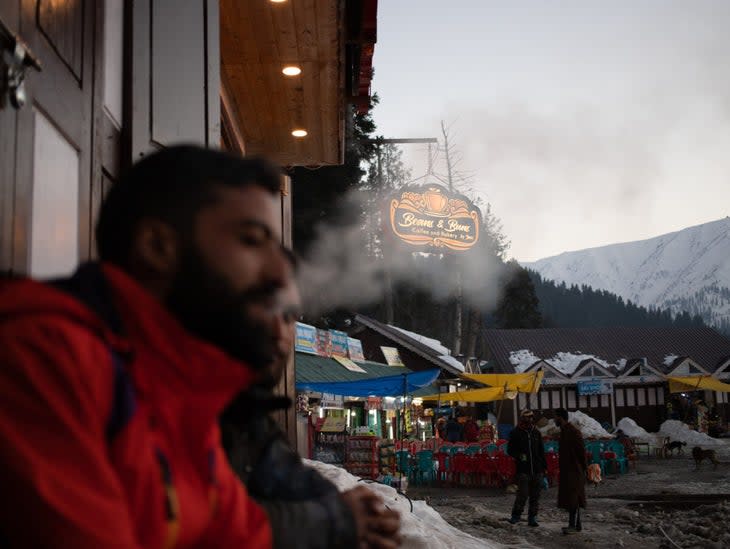
It also brings the true admirers of Gulmarg--the skiers--from Europe and the United States. Photographer Zishaan Latif and I have traveled from Delhi for eight days to witness the convergence of cultures in this winter hamlet.
Around 35 miles west of Srinagar, the valley sits at 8,530 feet. There are no residential houses, but dozens of pitched-roof hotels and wooden huts line the boundary of the skiable terrain. Tucked into the mountainside is a row of eateries with plastic chairs under large umbrellas out front. Patrons enjoy hot lamb dishes like Rishta meatballs, Kebabs served with rice, and Indian snacks like parathas and samosas.
Local Kashmiris sell hot tea, packaged water bottles, chocolates, and colorful goggles from their stands. Shop owners rent skis to tourists who only want to hold them like props in their photographs. Tourists, mainly from mainland India, crush snow in their hands and toss it at each other while others fall back on the white surface in amazement. Some are seeing snow for the first time.
The scene plays out like a busy market as skiers descend the slopes behind the village.
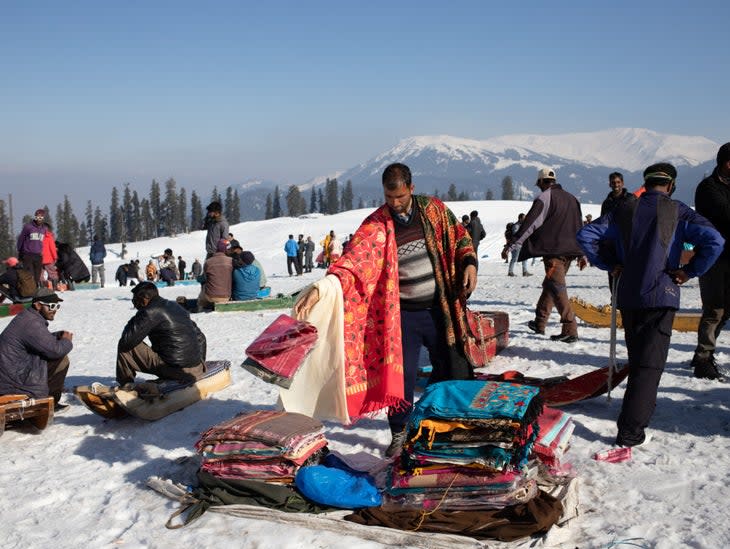
Looking around, it is impossible to know that violent conflict over control of the region has raged since 1947 when India and Pakistan gained independence from British colonial rule. The disputed border between India and Pakistan, known as the Line of Control, passes just a few miles from the ski slopes where landmines litter the earth, and thousands of troops face each other, ever ready for combat.
Gulmarg, which translates to “meadow of flowers,” is believed by locals to be named by Yousuf Shah Chak, the ruler of Kashmir from 1579 to 1586, who frequented the valley and mountains surrounding it in the summer months for its vast and lush meadows, and countless lakes.
When the British started to overtake India by the mid-19th century, English officers frequented the region to escape the scorching heat of Indian planes. They soon realized the potential of Gulmarg as an apt ski destination. When the India Ski Club was born in 1927, British officers hosted annual ski competitions during Christmas and Easter, yet the locals, the people of Muslim-majority Kashmir, had no part.
Instead, they lived in impoverished conditions under the harsh laws and forced labor imposed by Hindu Dogra rulers who bought Kashmir from the British.
When British rule ended in 1947, paving the way for the Muslim nation of Pakistan, tribal militias from the newly created Pakistan crossed over to Kashmir to aid the ongoing rebellion against the Hindu ruler Hari Singh until the war ended in 1949. Kashmir was divided between India and Pakistan, and leaders drew the ceasefire line near Gulmarg, a few miles from the ski area.
In the subsequent years, as peace returned to Kashmir, the government shifted its focus toward winter sports to bring much-needed vitality to the region. The Gulmarg Winter Sports Project was established in 1969 to retrofit the region as a winter destination. Ski instructors were needed, and 30-year-old Indian military officer Colonial S. P. Ahuja saw an opportunity. He had been trained at the High Altitude Warfare School, where soldiers learned skiing and winter warfare to fight in the treacherous mountains of Kashmir.
Ahuja and two other instructors decided instead of instructing soldiers. They would teach civilians and foreigners how to stay upright on skis--forming what is now known as the Indian Institute of Skiing and Mountaineering.
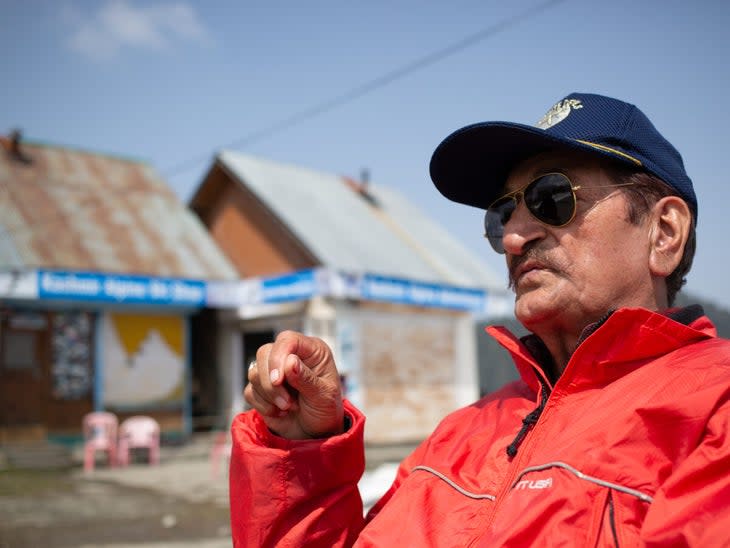
In the first winter, they picked up 30 students from across India and gave them a month-long course in skiing in Gulmarg. Most of them had never seen snow before.
One of those students was Yasin Khan, 67, who is now the owner of the Kashmir Alpine Ski Shop, Gulmarg's oldest ski shop. This is where Latif and I met Khan and Ahuja, now in his 80s. Seated in the spring sun, we have a clear view of the snow-draped valley and Apharwat Peak in the distance.
When he started working in Gulmarg, Khan was a 17-year-old boy from a farming family in nearby Tangmarg, ferrying tourists on a sled. He would guide them through the meadows and carry their belongings for two rupees daily, plus tips. (One US dollar equals 81 rupees today).
While training at the Indian Institute of Skiing, he met foreigners, sometimes offering to guide them through the surrounding mountains. One day, he went with an Australian man toting a brand new pair of Fisher skis.
“I knew the shortcut to mountains, and he was happy to take me along,” Khan recalls.
Guiding him to the unexplored slopes, Khan spent the next few days with the man who left him stunned by his off-piste skiing. “When he was leaving, I asked him, ‘Would you sell me the skis?” says Khan. The skis cost about $400, or 2,800 rupees at that time. He looked at all the money he had saved to his name and offered the Australian 2,000 rupees. The deal was done. A few weeks later, Khan bought his first pair of ski boots in a similar exchange.
“For the next 26 years, I was the single guide here, taking everyday skiers up the mountain and skiing down," Khan says with pride. "It was a time when word spread around the ski community of the world, and we had hundreds of foreign skiers coming every season. They loved the free, open mountains, its powder, and cheap accommodations.”
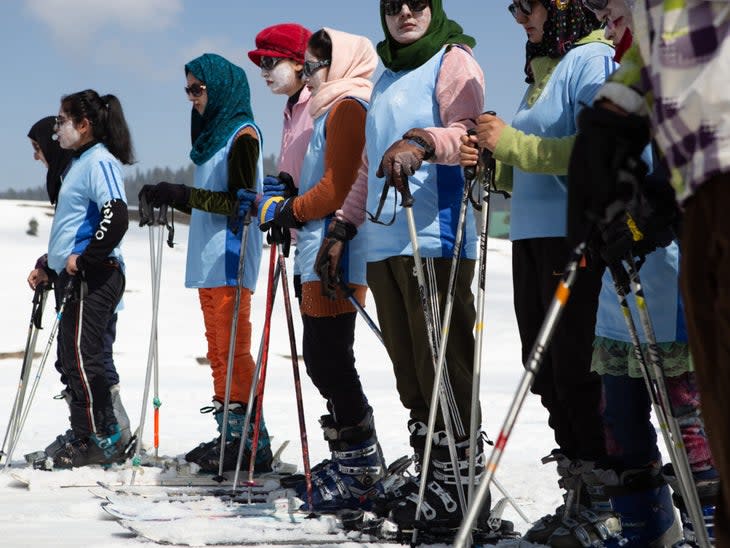
Khan also learned to ski better from his clients and also picked up English. He never attended school but developed a deep understanding of the world and its politics by guiding foreigners. By 1980, Khan had collected 20 pairs of skis and used them to open the first commercial ski rental store in Gulmarg.
Around that time, seeing the influx of skiers, the Indian government also started to invest in Gulmarg’s economy: working on the infrastructure, putting in the first chair lift, and installing a few surface lifts. Skiers continued to come. In 1987, the government built a gondola to take guests from Gulmarg Village to Kongdori, a large open bowl halfway up Apharwat Peak. More than 700,000 tourists flocked to Kashmir that year, up from the year prior, but the steady growth soon hit another violent roadblock.
The following winter, an armed rebellion broke out against Indian rule in Kashmir. Bombs went off across the region, targeting the Indian military and whatever resembled the Indian administration. Men wielding automatic weapons stood in the streets. India called in tens of thousands of additional troops to crush the rebellion. Hundreds of people--civilians, mostly--were killed. The world accused Indian forces of grave human rights violations, including torture and rape. Human rights organizations put the estimated number of people killed in the conflict in the next few years at more than 50,000.
Many Western nations issued advisories against visiting Kashmir, and in 1990, the number of tourists visiting Kashmir dropped to 6,000. The final halt to foreign tourists came in 1995 when Al Farhan militants kidnapped six backpackers, including two Americans, in southern Pahalgam just 90 miles east of Gulmarg Ski Area. Only one hostage managed to escape.
"Gulmarg was empty, ” remembers Khan. "There were no people. Shops and eateries were shut. I was skiing alone on the empty slopes." Business stopped and Khan had to manage expenses from his savings. “It was a difficult time for everyone.”
Violence in Kashmir slowly subsided by the new millennium, but the ’90s changed the region forever. Anywhere else in the world, skiers would flock to the unbeatable terrain Gulmarg offers. But the omnipresent threat of violence stunted its growth decades in the making, leaving some of the world's most incredible ski terrain largely untouched.
Today in Gulmarg, hundreds of people stand in a long queue snaking into the wood-paneled base station of the gondola.
It looks like a busy Indian railway station. Local hawkers sell handicrafts near the crowded counter where skiers purchase tickets: $15 US for the ride to the top.
Up to six hundred people are ferried in an hour, and 5,000 tickets are issued daily, usually sold out by noon, but only 300 are skiers. The rest are curious tourists, usually wearing rented rubber boots to walk through the snow. They leave quickly, repelled by the chilly winds, but not before capturing a few photos of the breathtaking high peaks and spectacular views of the vast valley below.
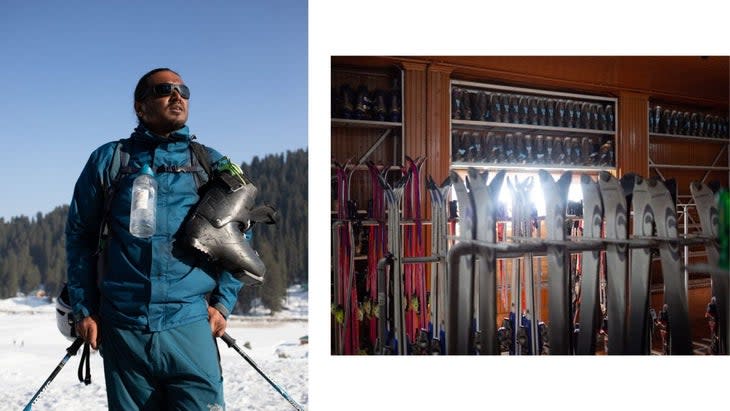
It is one of the world’s highest and longest cable cars, unveiling a panoramic view of enormous, skiable mountains. To the west, a clear day will reveal a breathtaking view of the mighty Karakoram Range, including the second-highest peak on earth, K2, at 28,251 feet.
The ques zigzags to the station’s first floor, passing by stalls of more handicrafts. The salesmen haggle rates with potential customers, who inch forward slowly for their gondola ride.
In 10 minutes, we are lifted to Kongdori, the highest station, passing over snow-covered dokhs--mud and wood huts where nomadic tribes migrate during the summers. Below us, men pull sleds up the mountain, where tourists ride them down.
We unload the gondola and shuffle with the others to load the chairlift taking the skiers to the Marry Shoulder, a ridge between Kongdori and the summit of Apharwat Peak.
There, we meet Brian Newman, Gulmarg’s lead snow safety officer.
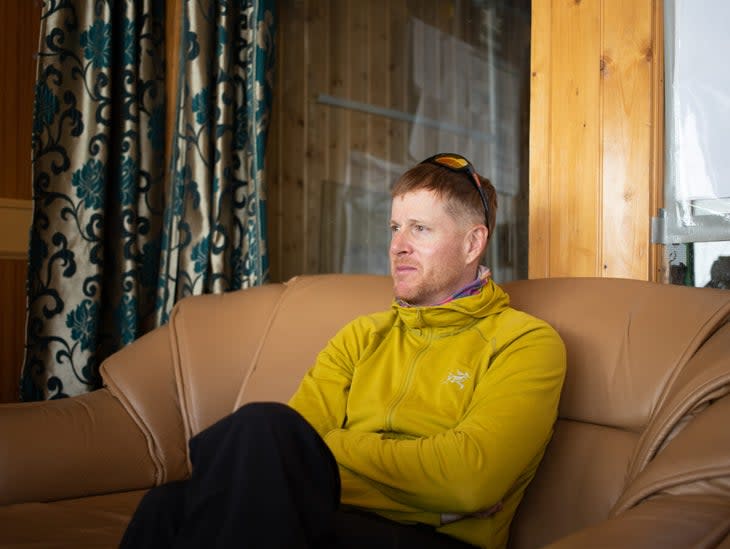
Everyone in Gulmarg’s ski community knows the angreaz, as Westerners are commonly referred to, for his fluent Kashmiri and Urdu, and, more importantly, for bringing up a world-class ski patrol 15 members strong. A lanky man from Colorado, Newman has spent 11 seasons working to develop the program at Gulmarg.
Newman has been a snow safety officer in North America and beyond for 35 years and first came to Gulmarg in 2008 when he was hired to oversee the risk management team.
After learning the local languages, Newman taught search and rescue protocols, snow science, and avalanche mitigation to the other patrollers--Kashmiri government employees working at the ski resort. A few had been taught basic ski safety by Western instructors who visited before Newman, but most knew little more than the basics of skiing.
Wearing his patroller red jacket, Newman skis down from Marry Shoulder to Kongdori under clear blue sky. His confident speedy maneuvers on bright white powder make him stand alone as he passes by other skiers who cautiously make their way down.
The Line of Control-the disputed border between India and Pakistan-- Despite the huge military presence along the disputed border, willing backcountry skiers (mostly foreigners) explore the vast backcountry terrain.
It's been largely peaceful in Kashmir for the last 20 years, though as recently as 2019, the Indian government revoked the limited autonomy of the region, imposing harsh physical and communication restrictions that resulted in the longest internet shutdown anywhere in a democracy in the world. Gulmarg was draped in a deafening silence for over a year, except for the army trucks headed to the border.
It's all part of what leaves Gulmarg teetering on the edge of becoming an impassable ski destination for local and international skiers--a haven for cooler temperatures and natural beauty in an otherwise harsh climate.
Gulmarg again came to the spotlight in 2022 after alpine skier Arif Khan, 31, qualified for the Beijing Winter Olympics. The only Indian athlete there, he was also the first from the country to compete in Slalom and Giant Slalom.
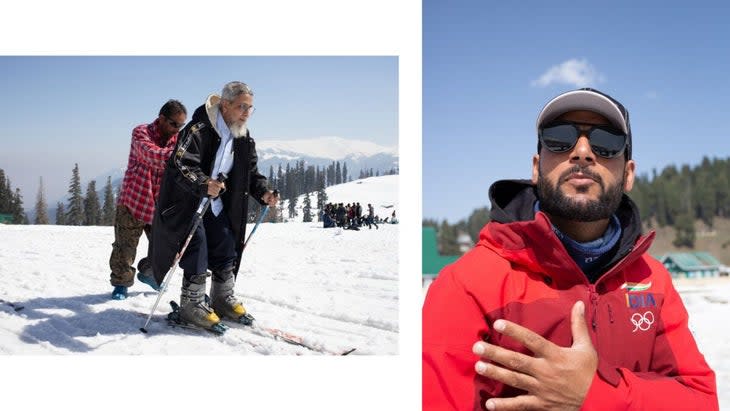
Arif is the son of Yasin Khan, the ski shop owner, who brought him to Gulmarg as a toddler and started training him in skiing as soon as he started walking when he was four.
When Arif visits the ski area and his father’s shop, people flock to shake his hand, hug him, and have their pictures taken with him. Because of the limited ski season and lack of infrastructure at Gulmarg, Arif travels to Europe and other parts of the world to train at the elite level. He credits his father’s contacts in the ski industry for the opportunity.
Now, he is trying to raise awareness and convince officials to build the proper infrastructure for growing skiing in Kashmir. The notoriety from competing in the Winter Olympics has now given him a platform, Arif says.
“Gulmarg has one of the best mountains for freeride skiing. I have skied around 420 ski resorts in the world, and this place is one of the best,” says Arif. “The views are breathtaking; the sunshine and the weather are all suitable for a ski destination.”
But it seems every time the region gains some momentum in the right direction, the reality of its precarious location sets in to derail it.
The next day, we stayed with the inbound skiers lapping the lift to the Marry Shoulder.
We're joined mostly by young Indian skiers from the cities, including a woman named Neha, who's waiting for her husband and two young kids to ski down from the top of the gondola. A banker from New York, she and her husband have visited most of the popular ski resorts in North America and found they desperately missed skiing after moving to India in 2017. After pandemic-related travel restrictions were lifted in the country, they immediately booked a two-hour flight from Mumbai for their first ski trip in Gulmarg.
"The slopes here are amazing," she says. "The great part is the snow and proximity of the mountains and the hospitality and warmth of the people."
Neha, who learned to ski about ten years ago in her 30s, finds it comforting to see others at Gulmarg also learning to ski for the first time as adults. "I don't feel low on confidence as I do in the West where people are trained at a very young age and you feel awkward as a learning adult," she says.
For what they would have spent on flights to European ski destinations, they can spend ten days skiing here, she adds.
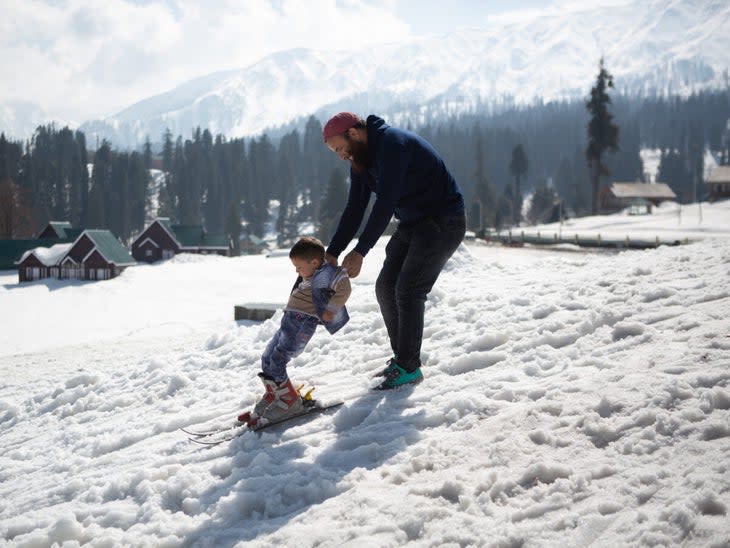
So she doesn't mind that Gulmarg is still using the same surface lifts that have been in use for the last forty years or that the first snow groomers that came to Gulmarg in 1982 are still the machines in use, with hardly any new additions.
There's still plenty of luxury, from high-end hotel options costing $400 a night for a slopeside accommodation with a spa and views of the Himalayas. Heli skiing is an option for guests willing to shell out the $120 daily cost.
Bilal Bakshi launched Kashmir Heliskiing in 2011 and says it gave a new name to Gulmarg, attracting extreme skiers who were otherwise reluctant to come to Kashmir. Griffin Post and Ian Mcintosh filmed segments in Gulmarg for Teton Gravity Research’s 2016 film “Tight, Loose."
"Our snow [in Kashmir] does not get affected by the sun because of the high altitude," explains Bakshi, who splits his time between Gulmarg and British Columbia. "In Europe and New Zealand and other places, it gets windy and starts raining in the middle of winter. But the Himalayas are incredible."
That afternoon, From the Marry Shoulder, massive snow-draped ridges unfold before eyes, with a breathtaking view and heavenly calm under the bright sun. The temperatures remain slightly below zero degrees Celsius, and the powdery snow complements it for a perfect ski run.
Back on the slopes where Neha is reconnecting with her family, showing her two children and her husband what she's learned in her lesson, another mother is also learning to ski for the first time.
Rohini Rana and her nine-year-old son have come to Gulmarg from New Delhi to ski. Her husband is an Indian army officer, but the couple haven't seen each other for six months--he's one of the soldiers posted on the border north of the ski area. Because of this, seven rifle-wielding soldiers surround him on the snow for her son’s safety.
All around them, skiers take the lift up before pointing rented skis down the low-angled slope, laughing as they make large S-turns across the snow.
For exclusive access to all of our fitness, gear, adventure, and travel stories, plus discounts on trips, events, and gear, sign up for Outside+ today.

